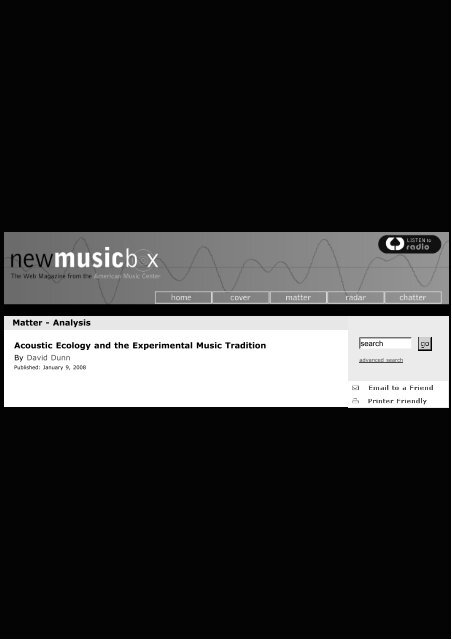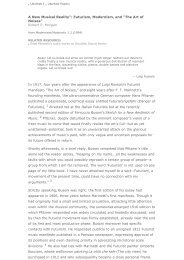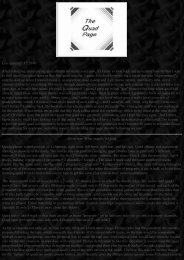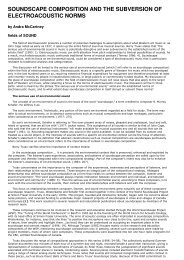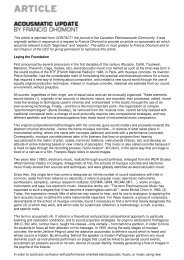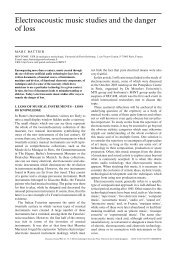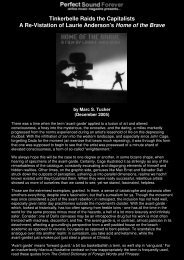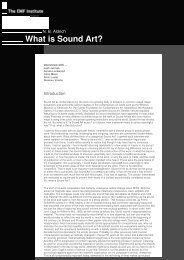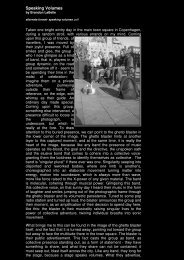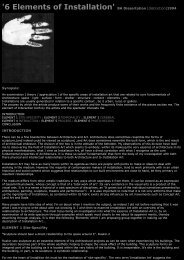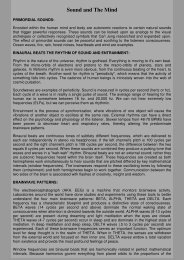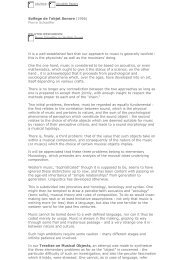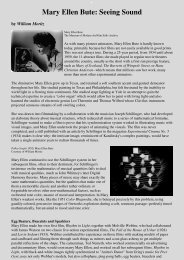Dunn-2008-Acoustic Ecology and the Experimental Music Tradition ...
Dunn-2008-Acoustic Ecology and the Experimental Music Tradition ...
Dunn-2008-Acoustic Ecology and the Experimental Music Tradition ...
- No tags were found...
You also want an ePaper? Increase the reach of your titles
YUMPU automatically turns print PDFs into web optimized ePapers that Google loves.
Matter - Analysis<strong>Acoustic</strong> <strong>Ecology</strong> <strong>and</strong> <strong>the</strong> <strong>Experimental</strong> <strong>Music</strong> <strong>Tradition</strong>By David <strong>Dunn</strong>Published: January 9, <strong>2008</strong>searchadvanced search
A recent composition of mine, FiveMicro-Worlds, includes <strong>the</strong> stridentscratching of ants communicatingdeep in <strong>the</strong>ir underground nest, <strong>the</strong>quiet wheezing <strong>and</strong> buzzing noises ofunderwater invertebrates infreshwater ponds, <strong>the</strong> eerie ultrasonicecholocation bursts <strong>and</strong> singing ofmany different species of batsreflecting back from rock crevices atnight—pitch-shifted into ourhuman-hearing range—<strong>and</strong> <strong>the</strong>insistent chirping <strong>and</strong> scraping of tinybeetles chewing through <strong>the</strong> innerbark of pine trees. These are allsounds that are not audible tohumans without <strong>the</strong> aid of specialDavid <strong>Dunn</strong>Photo by Naomi Milnerecording devices, <strong>and</strong> this is one of <strong>the</strong> things that I do as a composer: bring forth<strong>the</strong> sonic presence of <strong>the</strong>se worlds for human contemplation of <strong>the</strong>ir inherentaes<strong>the</strong>tic beauty <strong>and</strong> to show <strong>the</strong> amazing continuity of life, with its capacity forinfinite variation in audible communication.Every so often over <strong>the</strong> past decade, I have had a recurrent experience where uponbeing invited to lecture <strong>and</strong> present this kind of work at an institution, I find myselfadvertised as an "acoustic ecologist." While I never argue with thischaracterization—I'm usually unsure of <strong>the</strong> specific rationale for its use—I have neverapplied <strong>the</strong> original meaning of <strong>the</strong> term <strong>Acoustic</strong> <strong>Ecology</strong> to myself, been affiliatedwith its originators, nor used it to describe what I do (with one notable exceptionwhere it was used to highlight some of <strong>the</strong> issues addressed by this essay). All <strong>the</strong>while, I remain deeply sympa<strong>the</strong>tic to it. Perhaps <strong>the</strong>re is some confusion afoot in <strong>the</strong>worlds of art <strong>and</strong> music about what <strong>the</strong> term means, but <strong>the</strong>re's also a vagueintuition of its appropriateness for describing a much more expansive domain ofintellectual activity than would have ever been claimed by its original practitioners.This essay is an attempt to put some of <strong>the</strong>se conflicting assumptions into perspectivewhile also clarifying some of my own insights into related issues.The history of <strong>the</strong> collective of ideas generallyassociated with <strong>the</strong> term <strong>Acoustic</strong> <strong>Ecology</strong> is usuallywritten from a perspective that locates it as anacademic trademark. There is certainly validity in thisapproach, especially for <strong>the</strong> practitioners of its mostspecific usage to define distinct boundaries for amovement that began in <strong>the</strong> early 1970s in westernCanada. However, <strong>the</strong> term's scientific ring hasbeckoned a younger generation to its broaderimplications <strong>and</strong> many of <strong>the</strong>se newly interestedadherents come to it with more of an environmentalconservation <strong>and</strong> media art/science background than ahistorically focused knowledge of <strong>the</strong> ideas of composerR. Murray Schafer—who, most likely, first formallycoined <strong>the</strong> term. While I plan to give due attention tohis generative role, I wish to place an underst<strong>and</strong>ing ofthat role into a larger context that has evolvedsomewhat consciously from its original intentions but, R. Murray Schaferas importantly, from activities that developedindependently, in parallel to, or in reaction against it. Current usage of <strong>the</strong> term cannow be found to describe any or all of <strong>the</strong>se sometimes contradictory positions.While Schafer's ideas are rich <strong>and</strong> unquestionably profound, some are also sufficientlygeneral as to be readily summarized:1.Our modern 20th-century culture—but by no means all human cultures whe<strong>the</strong>rextant or extinct—tends to privilege our underst<strong>and</strong>ing of reality through oursense of sight; <strong>and</strong> this preference for visual experience also becomes manifestthrough our predominant use of language metaphors based upon <strong>the</strong>se visualexperiences. Aural experience is largely pushed fur<strong>the</strong>r into a backgroundperception, <strong>and</strong> we pay for this diminishment with a loss of sensitivity <strong>and</strong>awareness towards certain aspects of our environment.
2.3.The framing of <strong>the</strong> concept of "<strong>the</strong> soundscape" as a defining metaphor forperceptually pulling forth <strong>the</strong> auditory characteristics of an environment intoforeground attention <strong>and</strong> insisting that <strong>the</strong>se sonic attributes be regarded as aconsistent organizing factor—not only for how <strong>the</strong> environment is defined <strong>and</strong>experienced, but as an essential feature for defining <strong>the</strong> historical <strong>and</strong> ongoingsocial relationship of humans to that environment.The necessity to heighten awareness of <strong>the</strong> negative consequences of certainhistorical developments in human societies that have resulted in <strong>the</strong> loss oftraditional knowledge conveyed through sound or, similarly, <strong>the</strong> increase ofindustrial "noise" that has both a disintegrating social impact <strong>and</strong>psycho-physiological destructive aspect. This concern has often been simplifiedinto issues of "noise pollution" <strong>and</strong> confounded with <strong>the</strong> more direct agenda ofenvironmental acoustics.The evolution of Schafer's ideas can be traced through his sequence of extraordinarywritings, starting with many of <strong>the</strong> general concepts, moving through curriculumoutlines <strong>and</strong> listening exercises, <strong>and</strong> eventually to <strong>the</strong> defining of a lexicon of formallanguage for framing all of <strong>the</strong>se ideas towards heuristic application <strong>and</strong> research.During <strong>the</strong> expansion of <strong>the</strong>se concepts, <strong>the</strong>re formed a larger collective of colleaguesthat became known as <strong>the</strong> World Soundscape Project. Books <strong>and</strong> recordings werepublished that demonstrated many of <strong>the</strong> group's core concerns <strong>and</strong> a st<strong>and</strong>ardarsenal of tools <strong>and</strong> strategies for increasing listening sensitivity to <strong>the</strong> environmentwere codified: soundscape recording, list making, oral history recording, various formsof sound mapping, amplitude <strong>and</strong> spectral charting of auditory spatial locations, soundwalks, <strong>and</strong> many o<strong>the</strong>r types of listening exercises that were especially geared foreducational uses with children. Overall <strong>the</strong> group produced a combination of activitiesdrawn from both <strong>the</strong> emphasis on experiential education that was burgeoning at <strong>the</strong>time <strong>and</strong> a form of quantifiable communication <strong>the</strong>ory that is more characteristic of<strong>the</strong> social sciences than of musicology. Diaries <strong>and</strong> field observations of specificgeographic locations (Vancouver <strong>and</strong> several European villages) resemblingethnographic field notes were made <strong>and</strong> data collected to subsequently createingenious charts <strong>and</strong> maps showing correlations between sonic l<strong>and</strong>marks <strong>and</strong>patterns of social organization <strong>and</strong> history.While <strong>the</strong> principal metaphor that Schafer used to formulate his concept of <strong>Acoustic</strong><strong>Ecology</strong> <strong>and</strong> <strong>the</strong> World Soundscape Project was <strong>the</strong> value of listening to <strong>the</strong>soundscape as if it were a musical composition—<strong>and</strong> even participating in how thatsoundscape gets "composed"—<strong>the</strong>re also seemed to be a dramatic schism betweenhis interests as a composer <strong>and</strong> <strong>the</strong> maintenance of <strong>the</strong> WSP as a somewhatabstract—<strong>and</strong> didactic—research project. The two always seemed separate in his mind<strong>and</strong> creative output. <strong>Acoustic</strong> <strong>Ecology</strong> may have been inspired by music but neverbecame music <strong>and</strong>, conversely, some of his music may have been influenced by<strong>Acoustic</strong> <strong>Ecology</strong> but never became "<strong>Acoustic</strong> <strong>Ecology</strong>" except in <strong>the</strong> mostrudimentary <strong>and</strong> academic of cases.In recent years this has somewhat shifted. As composer Warren Burt has remindedme, Schafer has been staging a series of ritualistic operas in <strong>the</strong> remote Canadianwilderness called Patria. Warren has made <strong>the</strong> excellent point that <strong>the</strong>se eventsrequire a real commitment on <strong>the</strong> part of <strong>the</strong> audience—sometimes several days ofhiking to, <strong>and</strong> living in, <strong>the</strong> performance locale—<strong>and</strong> <strong>the</strong>refore represent a seriousattempt at a renewal of <strong>the</strong> social function of music, one that moves much closer toreconciling Schafer's earlier music <strong>and</strong> his <strong>Acoustic</strong> <strong>Ecology</strong> concerns.In many ways <strong>the</strong> current expansion of <strong>the</strong> term <strong>Acoustic</strong> <strong>Ecology</strong>—which o<strong>the</strong>rwiseseems historically appropriate—is reinforced by a largely conservative musicalestablishment—especially in academia—interested in placing experimental musicalactivity into a zone of non-musical status. The term provides for a convenientoutlying conceptual domain where much sound-based art that o<strong>the</strong>rwise isthreatening to traditional musical values can, from that perspective, be exiled withoutuncomfortable argument. This can also be said about <strong>the</strong> split that has taken placebetween "concert music" <strong>and</strong> "sound art," where <strong>the</strong> latter has often been a forcedcategorization for certain kinds of experimental practice that aes<strong>the</strong>tically conflict withmore conservative musical assumptions: if it doesn't conform to certainpreconceptions about music, <strong>the</strong>n call it something else so those assumptions won'tbe seriously challenged.As a composer, Schafer has essentially been a Romantic Modernist (by no meansmeant as a pejorative) here defined as an interest in exp<strong>and</strong>ing <strong>the</strong> expressivepalette of music while maintaining an essentially 19th-century aes<strong>the</strong>tic concept of
what <strong>the</strong> social role <strong>and</strong> purpose of music should be. As such he could notaccommodate his insights about environmental sound into his music, <strong>and</strong> <strong>the</strong> logicalway open to him was to define a new intellectual discipline. I believe that RomanticModernism is still <strong>the</strong> dominant aes<strong>the</strong>tic paradigm of 20th-century music—bothpopular <strong>and</strong> classical—but that <strong>the</strong>re are o<strong>the</strong>r parallel paradigms that have existed<strong>and</strong> continue to thrive in <strong>the</strong> world today. One of <strong>the</strong> most important of <strong>the</strong>se is anexperimental tradition that bifurcated away from <strong>the</strong> predominantly European19th-century belief that music must express "self" <strong>and</strong> "emotion." It is also a traditionconcerned with achieving many of Schafer's <strong>Acoustic</strong> <strong>Ecology</strong> concerns but throughactive creative strategies that emphasize <strong>the</strong> materiality of sound, listening,environment, perception, <strong>and</strong> socio-political engagement.Ra<strong>the</strong>r than focusing upon <strong>the</strong> special talents of a composer at "expressing" selfthrough a dramatic structure <strong>and</strong> highlighting <strong>the</strong>ir compositional training <strong>and</strong> skill atdoing so, this is a tradition that is more interested in making a form of music thatdraws attention to <strong>the</strong> structure of auditory perception itself <strong>and</strong>/or issues of soundas an organizing factor in both human <strong>and</strong> non-human living systems. While it isconvenient in this context to pose <strong>the</strong>se paradigms as dichotomous in nature, it isreadily apparent that <strong>the</strong> two can also be compatible. There are a large number ofcreative musicians who not only move back <strong>and</strong> forth between <strong>the</strong>se sonic worlds, butalso manage to combine <strong>the</strong>m in extraordinary ways.For example, Larry Polansky has oftenmanaged to keep one foot firmly planted ineach of <strong>the</strong>se worlds, integrating musicallyexpressive concerns with an exploration ofnew ma<strong>the</strong>matical <strong>and</strong> psychoacousticconcepts. His compositions oftensimultaneously succeed on two differentlevels. Similar statements can be madeabout <strong>the</strong> aforementioned Warren Burt. Heconstantly moves in <strong>and</strong> out of a diversearray of musical sound worlds, sometimespurposefully confounding our preconceptionsabout both experimental process <strong>and</strong>traditional musical expression. DavidBehrman's live computer works harvestleading-edge technologies <strong>and</strong> perceptual<strong>the</strong>ories to create a highly sensuous concertDavid BehrmanPhoto by Terri Hanlonexperience. Annea Lockwood has created works that are classics within <strong>the</strong> <strong>Acoustic</strong><strong>Ecology</strong> tradition, but also highly expressive instrumental works. We can also see howsome of <strong>the</strong> most highly recognized composers of our time (Philip Glass <strong>and</strong> SteveReich) began <strong>the</strong>ir careers in one of <strong>the</strong>se modes of interest, experimenting with <strong>the</strong>perceptual effects of entrained repetition, <strong>and</strong> <strong>the</strong>n moved into being almostexclusively concerned with quite conventional forms of musical expression.The antecedents for <strong>the</strong> experimental view also extend back through <strong>the</strong> 20thcentury. In fact, much of <strong>the</strong> project of modernism can be seen as attempts to focushuman consciousness towards <strong>the</strong> reality of <strong>the</strong> street <strong>and</strong> <strong>the</strong> forest. How music hasparticipated in this process was summarized by Australian media <strong>the</strong>orist Sean Cubittat <strong>the</strong> Seventh International Symposium on Electronic Art (ISEA 96): "<strong>Music</strong> <strong>and</strong>information dominate <strong>the</strong> hearing of <strong>the</strong> twentieth century, <strong>and</strong> <strong>the</strong>ir dialectic hasonly recently begun to evolve a third mode of hearing, <strong>the</strong> soundscape. <strong>Music</strong> fromRussolo to Cage strips itself of inessentials—melody, harmony, counterpoint—toencompass all hearing, transferring <strong>the</strong> musician's mode of listening to <strong>the</strong> sounds of<strong>the</strong> world."Clearly Schafer's desire to hear <strong>and</strong> compose <strong>the</strong> soundscape as a piece of music wasearlier expressed by Cage—within a more philosophical wrapping—who insisted thathis activity was always essentially musical in nature. Starting at least a full decadebefore Schafer began to articulate <strong>the</strong> basic assumptions of <strong>Acoustic</strong> <strong>Ecology</strong>, JohnCage, <strong>and</strong> <strong>the</strong> musicians closest to him (David Tudor <strong>and</strong> Morton Feldman), hadtransferred creative emphasis away from acts of self-expression towards perceptualacts of listening to non-semantically organized sounds as a strategy for focusingawareness to <strong>the</strong> reality around us. At <strong>the</strong> same time, two o<strong>the</strong>r associates of Cage,Christian Wolff <strong>and</strong> Earle Brown, <strong>and</strong> ano<strong>the</strong>r composer who was not part of Cage'sNew York circle, Herbert Brun, applied similar aes<strong>the</strong>tic breakthroughs to explorationsof music as a model for social interaction.During <strong>the</strong> two decades (1960s <strong>and</strong> 1970s) that Schafer was first formulating
data sonification, <strong>the</strong> aural equivalent to computer visualization techniques throughwhich streams of data are made more direct <strong>and</strong> experiential to researchers <strong>and</strong> <strong>the</strong>general public. The intervening years have also seen <strong>the</strong> emergence of a newresearch area known as bio-musicology as an attempt to formalize thinking about <strong>the</strong>biological origins of music.While all of <strong>the</strong>se events have to some extent more precisely advanced issuesoriginally put forth by <strong>Acoustic</strong> <strong>Ecology</strong>, fur<strong>the</strong>r blurring its original meaning <strong>and</strong>intellectual focus, <strong>Acoustic</strong> <strong>Ecology</strong> has itself influenced o<strong>the</strong>r disciplines beyond music<strong>and</strong> <strong>the</strong> arts. In several articles since his original fieldwork in Papua, New Guinea,anthropologist <strong>and</strong> ethnomusicologist Steven Feld has acknowledged Schafer'sinfluence upon his thinking about <strong>the</strong> role of sound perception as a unique organizingforce within culture. He has even gone on to fur<strong>the</strong>r innovate <strong>the</strong> methodologicalassumptions of his disciplines by pursuing a form of creative soundscape compositionthat is firmly grounded in <strong>the</strong> ideas of <strong>Acoustic</strong> <strong>Ecology</strong>.Taken toge<strong>the</strong>r, all of <strong>the</strong>se developments, whe<strong>the</strong>r originally based within <strong>the</strong> arts or<strong>the</strong> sciences, have blurred former distinctions while attempting to delineate new ones.While some of <strong>the</strong> emerging genre categories seem arbitrary—<strong>and</strong> in some cases asra<strong>the</strong>r transparent attempts by individuals to stake out turf boundaries—o<strong>the</strong>rs maystick for some time <strong>and</strong> even stabilize into fully-fledged research or aes<strong>the</strong>ticdomains. It is obvious that some commentators within <strong>the</strong> traditional music worldhave seen <strong>the</strong> development of <strong>the</strong>se new events <strong>and</strong> genres as directly hostile totraditional musical values. Meanwhile, many "sound artists" have seemed eager topart from <strong>the</strong> music world's aes<strong>the</strong>tic <strong>and</strong> educational expectations. They oftenreinvent concepts that <strong>the</strong> experimental music community has always embraced butcan now be retrofitted into <strong>the</strong> art market gallery system. My position is that many of<strong>the</strong>se new fields are a logical evolution in musical practice ra<strong>the</strong>r than a break with it.If music in any way reflects <strong>the</strong> evolving human condition, <strong>the</strong>n this is what weshould have expected music to become in <strong>the</strong> 21st century.As a parallel way of thinking to <strong>the</strong> visually dominant metaphors of human speech<strong>and</strong> written symbols, music is also a kind of conserving strategy for ways ofcommunicating that are closer to how o<strong>the</strong>r forms of life may communicate. Eventhough it has been a means to organize <strong>and</strong> perceive communicative sonic patterns,it is only remotely related to human linguistic structures. From an environmentalviewpoint, music may have been a means through which humans structurally coupledto <strong>the</strong> larger systems of mind that comprise our natural <strong>and</strong> social environments.Beyond <strong>the</strong> cultural richness <strong>and</strong> entertainment that recent uses for music afford us,assumptions about musical authorship, communicative intention, emotionalexpression, <strong>and</strong> musical genius may—in evolutionary terms—be short-termphenomena <strong>and</strong> even distractions from a more profound significance.Failed attempts to identify objective content of expression within <strong>the</strong> musical objectare as numerous as those that have tried to assign <strong>the</strong> phenomena of mind to aspecific locus. As a distributed network of signification, musical semantics emergefrom an infinite set of superabundant associations <strong>and</strong> uses that cannot be fixedexcept through somewhat arbitrary <strong>and</strong> geographically limited cultural agreements.The continued dominance of 19th-century assumptions about musical value beingdetermined by our belief in its capacity to convey self-expression <strong>and</strong> emotionalcontent arises from this condition. The cliché that music is a universal language is achimera.While <strong>the</strong>re may be certain physiological constants that contribute to stableperceptual factors that we associate with musical experiences—<strong>the</strong> fact that we haveyet to discover a human society without it seems particularly significant, as dodiscoveries about <strong>the</strong> ability of music-making to alter <strong>the</strong> hardwiring of braindevelopment—we are only beginning to scratch that particular research surface. Wecurrently know very little, <strong>and</strong> too much of <strong>the</strong> psychoacoustic research tends to grindan ideological axe from aes<strong>the</strong>tic biases or is fooled by simplistic semantics <strong>and</strong> falsedistinctions. For example, composer Kenneth Gaburo told me about a tellingconversation he once had with a prominent psychologist, who—in attempting todiscuss musical phenomena in <strong>the</strong> context of current <strong>the</strong>ories concerning hemisphericlateralization <strong>and</strong> localization of brain functions—had assigned melody to <strong>the</strong> lef<strong>the</strong>misphere of <strong>the</strong> brain (as a supposedly linear perceptual function) <strong>and</strong> chord to <strong>the</strong>right hemisphere (as a supposedly non-linear perceptual function). Kenneth pointedout how, in <strong>the</strong> process of composition, one often conceived of a chord as verticalizedmelody <strong>and</strong> a melody as a horizontalized chord. Therefore—given this potential for acreative shift in functional underst<strong>and</strong>ing—could such a simplistic hemisphericassignment be made? The psychologist responded by accusing Kenneth of being an
Aristotelian.In <strong>the</strong> light of insights inherited from <strong>the</strong> experimental music tradition <strong>and</strong> <strong>the</strong>broader meaning for <strong>Acoustic</strong> <strong>Ecology</strong> previously outlined, I am willing to contend thatthis capacity to hear <strong>the</strong> soundscape as music is simultaneously one of <strong>the</strong> mostarchaic ways of listening <strong>and</strong> <strong>the</strong> most modern. <strong>Music</strong> is both a conserving action forkeeping alive a mode of communication similar to non-human forms of cognition <strong>and</strong>an intuition to a future communication modality that we are actively evolving.Given <strong>the</strong> superabundance of how music as a human activity has been used, I believethat music has simultaneously been a strategy to evolve our capacity tostructurally-couple with our environment through our aural perception, <strong>and</strong> asignificant force for defining <strong>the</strong> boundaries of group affiliation <strong>and</strong> for <strong>the</strong> affirmationof cultural status, giving voice to an evolutionary heritage of an abundance of o<strong>the</strong>rcoupling modes that are greater than <strong>the</strong> rational mind alone.These admittedly controversial ideas are echoed in a recent hypo<strong>the</strong>sis bypaleoanthropologist Steven Mi<strong>the</strong>n in his book, The Singing Ne<strong>and</strong>erthals: The Originsof <strong>Music</strong>, Language, Mind, <strong>and</strong> Body (Harvard University Press, 2006). Mi<strong>the</strong>n hasbuilt upon <strong>the</strong> work of linguist Alison Wray, whose "holistic" <strong>the</strong>ory of proto-languageevolution has challenged <strong>the</strong> mainstream of "compositional" <strong>the</strong>ories to assert thatearly hominid proto-language was a root communication modality from which bothhuman speech <strong>and</strong> music bifurcated. Mi<strong>the</strong>n's principal contribution to this debate hasbeen his <strong>the</strong>ory that early human proto-linguistic communication must have hadattributes of both speech <strong>and</strong> music. He argues that early hominids communicatedthrough a kind of proto-linguistic music-speech, what musicologist Stephen Brown hastermed musilanguage. While music <strong>and</strong> language exhibit too many inherentdistinctions for ei<strong>the</strong>r to have evolved from <strong>the</strong> o<strong>the</strong>r, <strong>the</strong>y also share too manyfeatures to have had completely separate evolutionary origins. This leads us to <strong>the</strong>conclusion that both have evolved from a proto-linguistic precursor, something thatpossessed characteristics shared by both extant language <strong>and</strong> music.Besides how intriguing such research into <strong>the</strong> origins of language <strong>and</strong> music can be, itis directly germane to <strong>the</strong> current discussion about <strong>Acoustic</strong> <strong>Ecology</strong> <strong>and</strong> <strong>the</strong>experimental music tradition through implying that musical function can change overtime. What is particularly impressive about Mi<strong>the</strong>n's discussion of music is anunderlying respect for its great diversity <strong>and</strong> potential for continual evolution. If musicevolved from a proto-linguistic precursor <strong>the</strong>n it never has been something fixed inform or purpose but ra<strong>the</strong>r continually changes as a measure of what it means to behuman. Like species of life on Earth, <strong>the</strong>re have probably been more forms ofmusic—both individual <strong>and</strong> cultural—that have come <strong>and</strong> gone than are currentlymanifest on <strong>the</strong> planet. This inheritance of musical perception from ourproto-linguistic consciousness may also be a conservator of archaic ways of observing<strong>and</strong> underst<strong>and</strong>ing <strong>the</strong> profound spectrum of ways that we have—<strong>and</strong> stillmight—communicate between humans, <strong>and</strong> between humans <strong>and</strong> <strong>the</strong> non-humanworld.There is one final caveat to include before concluding this discussion of <strong>the</strong> linkbetween <strong>Acoustic</strong> <strong>Ecology</strong> <strong>and</strong> musical experimentalism. Such attempts to increaseour collective awareness of environmental issues by sensitizing us to <strong>the</strong> soundscapeare now four decades old. So what's next? Undoubtedly musicians, artists, scholars,<strong>and</strong> scientists will continue to use established practices <strong>and</strong> technologies to bringissues of <strong>the</strong> natural environment into foreground awareness through sound. They willalso invent new techniques <strong>and</strong> tools for this purpose. I also believe that awarenessof <strong>the</strong> historical moment—signaled through extensive loss of biological diversity, globalclimate change, <strong>and</strong> <strong>the</strong> impacts of human over-population—will dem<strong>and</strong> an evenfur<strong>the</strong>r shift in how <strong>the</strong> sonic arts move beyond purely expressive concerns, ordocumentary <strong>and</strong> sensory heightening strategies alone, towards participation in bothscientific research <strong>and</strong> subsequent interventions in growing environmental dilemmas.This is just ano<strong>the</strong>r stage in how music has always congruently evolved with humanneeds.I want to conclude by explaining my own stance regarding <strong>the</strong> necessity forrespecting <strong>the</strong> diversity of intellectual <strong>and</strong> creative opinions that make up our musicalmultiverse. My position is not intended to negate prior musical forms <strong>and</strong>assumptions. Such things do not disappear as long as <strong>the</strong>re are those among us whounderst<strong>and</strong>, appreciate, <strong>and</strong> value <strong>the</strong>m. As one of my mentors, Harry Partch, wasfond of reminding me, one can choose to live in <strong>the</strong> little world of one idea <strong>and</strong> onereality, or <strong>the</strong> big world of many ideas <strong>and</strong> many realities. I wish to argue that musicis never fixed, <strong>and</strong> that its evolution into new forms <strong>and</strong> uses is not hierarchical. The
existence of one thing does not cancel out <strong>the</strong> existence of ano<strong>the</strong>r, even if <strong>the</strong>y arecontradictory. Like any living ecosystem, a near infinite diversity of musical realitiescan coexist <strong>and</strong> be widely valued <strong>and</strong> that is <strong>the</strong> true meaning of our human heritageof music. As it becomes more <strong>and</strong> more evident how serious our environmentalchallenges truly are, <strong>the</strong> dual heritage of <strong>Acoustic</strong> <strong>Ecology</strong> <strong>and</strong> experimental music—inforegrounding our aural perception of <strong>the</strong> Earth—seems more urgent than ever. Whileno one can predict <strong>the</strong> exact outcome of <strong>the</strong> changes we bear witness to, it occurs tome that one of <strong>the</strong> best uses of our time as musicians is to find creative ways tolisten to some of nature's changing messages <strong>and</strong> pass <strong>the</strong>m along to o<strong>the</strong>rs.ReferencesR.M. Schafer, Ear Cleaning, BMI Canada, 1967.—. The New Soundscape: A H<strong>and</strong>book for <strong>the</strong> Modern <strong>Music</strong> Teacher, BMI Canada, 1969.—. The Book of Noise, Price Milburn <strong>and</strong> Company Limited, New Zeal<strong>and</strong>, 1973.—. The Tuning of <strong>the</strong> World, Knopf, New York, 1977. Republished as The Soundscape,Destiny Books, Rochester, Vermont, 1994.R. M. Schafer, ed., European Sound Diary, ARC Publications, 1977.—. ed., The Vancouver Soundscape, ARC Publications, 1978.Re-released as a double CD set that includes a 1996 comparative study: The VancouverSoundscape 1973/Soundscape Vancouver 1996, Cambridge Street Records CSR-2CD 9701,1996.—. ed., Five Village Soundscapes, ARC Publications, 1978.OrganizationsWorld Forum for <strong>Acoustic</strong> <strong>Ecology</strong><strong>Acoustic</strong> <strong>Ecology</strong> InstituteEar to <strong>the</strong> Earth***David <strong>Dunn</strong> is a composer <strong>and</strong>, maybe, an acoustic ecologist. He rarely presentsconcerts or installations <strong>and</strong> instead prefers to lecture <strong>and</strong> engage in site-specificinteractions or research-oriented activities. Current projects include <strong>the</strong> sonification ofdeterministic chaotic systems, research into <strong>the</strong> bioacoustics of bark beetles <strong>and</strong>entomogenic climate change, research on ultrasonic audio phenomena in both human<strong>and</strong> non-human environments, design of inexpensive wave-guides <strong>and</strong> transducersystems for environmental sound monitoring, <strong>and</strong> <strong>the</strong> design of self-organizingautonomous sound systems for spawning interaction between artificial <strong>and</strong> naturalnon-human systems. In 2005 he was <strong>the</strong> recipient of <strong>the</strong> Alpert Award for <strong>Music</strong> <strong>and</strong><strong>the</strong> Henry Cowell Award in 2007. He lives in Santa Fe, New Mexico. He can bereached at artscilab (at) comcast.net.New<strong>Music</strong>Box © 1998-<strong>2008</strong> About NMBX RSS Feed Join Us Sitemap Contact Us


